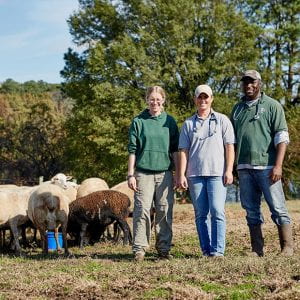John Jennings, Professor – Forages, Animal Sciences, University of Arkansas
(Previously published online with the Division of Agriculture Research and Extension, University of Arkansas)
Measuring  moisture content of forage cut for hay or silage is an essential step to ensure storage stability and product quality. Hay baled with too much moisture can mold or be subject to spontaneous heating. Silage baled or chopped at moisture contents outside a recommended range may not ferment properly, reducing storage life and animal acceptance. A relatively new method of measuring forage moisture content is through use of an air fryer. this household appliance is basically a small convection oven. it can be used at the farm shop or can be operated in the field from a generator to provide accurate forage moisture readings.
moisture content of forage cut for hay or silage is an essential step to ensure storage stability and product quality. Hay baled with too much moisture can mold or be subject to spontaneous heating. Silage baled or chopped at moisture contents outside a recommended range may not ferment properly, reducing storage life and animal acceptance. A relatively new method of measuring forage moisture content is through use of an air fryer. this household appliance is basically a small convection oven. it can be used at the farm shop or can be operated in the field from a generator to provide accurate forage moisture readings.
Steps for using an air fryer to measure hay moisture
Materials needed: Continue reading Measuring Forage Moisture Content Using an Air Fryer

 of their versatility, forages play an important role in modern small ruminant production systems as they can be grazed or harvested and stored as fermented or dry feeds for later use. Forages are unique as they contain structural carbohydrates, in the form of cellulose, that can only be digested by rumen bacteria. When compared with grain-based diets, one disadvantage that is associated with forage-based diets is the number of bacteria that are used to digest forages is much lesser than those used to digest grains (3 billion bacteria/mL of rumen fluid in forage-based diets vs. 8 billion bacteria/mL of rumen fluid in grain-based diets). Rumen bacteria provide ruminants with a large proportion of daily crude protein intake, therefore, diets that are greater in forages may result in less protein available on a per pound basis when compared with grain-based diets and thus require additional supplementation. However, this slight inefficiency should not be “the end all be all” as marginal lands not suitable row cropping or commercial development as well as environmental challenges negatively impacting row cropping systems may greatly benefit from the incorporation of forage production.
of their versatility, forages play an important role in modern small ruminant production systems as they can be grazed or harvested and stored as fermented or dry feeds for later use. Forages are unique as they contain structural carbohydrates, in the form of cellulose, that can only be digested by rumen bacteria. When compared with grain-based diets, one disadvantage that is associated with forage-based diets is the number of bacteria that are used to digest forages is much lesser than those used to digest grains (3 billion bacteria/mL of rumen fluid in forage-based diets vs. 8 billion bacteria/mL of rumen fluid in grain-based diets). Rumen bacteria provide ruminants with a large proportion of daily crude protein intake, therefore, diets that are greater in forages may result in less protein available on a per pound basis when compared with grain-based diets and thus require additional supplementation. However, this slight inefficiency should not be “the end all be all” as marginal lands not suitable row cropping or commercial development as well as environmental challenges negatively impacting row cropping systems may greatly benefit from the incorporation of forage production. can be marketed either as finished (ready for slaughter) or feeder lambs. The choice depends on the facilities a producer has for feeding out lambs and their willingness to regularly sort and market them as they reach the ideal weight and finish. If a producer plans to sell all of their lambs at one time, it may be better to sell them to a feedlot than to sell a mixed group of lambs for slaughter.
can be marketed either as finished (ready for slaughter) or feeder lambs. The choice depends on the facilities a producer has for feeding out lambs and their willingness to regularly sort and market them as they reach the ideal weight and finish. If a producer plans to sell all of their lambs at one time, it may be better to sell them to a feedlot than to sell a mixed group of lambs for slaughter. must pay attention to soil fertility, drying time, and storage to maximize both quality and quantity.
must pay attention to soil fertility, drying time, and storage to maximize both quality and quantity.
 of this week, live-breeding sheep and goats are eligible for import into the United States from Canada.
of this week, live-breeding sheep and goats are eligible for import into the United States from Canada. of 2021, the
of 2021, the  It Depends.
It Depends.